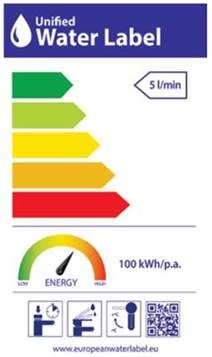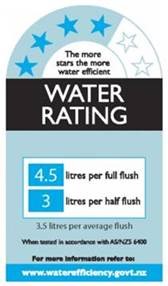
How can labelling help us reduce our water use?
Posted on: July 2019Andrew Tucker - Water Efficiency Manager at Thames Water
How can labelling help us reduce our water use?
| About the author: Andrew Tucker is the Water Efficiency Manager at Thames Water and is responsible for delivering the business’ water efficiency targets across London and Thames Valley. He is overseeing the development and delivery of multiple initiatives on household and business customers - delivered in parallel with Thames Water’s smart metering rollout and as large-scale bespoke demand management initiatives. Areas of work include large-scale in-home retrofitting, water audits, businesses and schools, and water efficiency communications, retail propositions, online tools, customer advice and delivering Per Capita Consumption targets. Andrew leads the development of Thames Water’s Affordability & Vulnerable Customer Strategy which covers social tariffs and priority services initiatives for vulnerable customers. Previously Andrew has been the Water Strategy Manager for the Energy Savings Trust; Principal Policy Officer for Climate Change Adaptation and the Manager of the London Climate Change Partnership at the Greater London Authority, and worked in the Australian mining industry as an Environmental Adviser, within coal and base metal mining and processing operations. |
 |
|
Across the nation, water fittings and appliances are being bought and installed every day. The daily grind of going to work, to school and just getting things done at home, means that 66 million people are using these fittings and appliances, morning and night. This adds up to an incredible amount of water – well over 9 billion litres used in just our homes each day. The water we drink and wash with is taken from local rivers, streams and underground aquifers, stored, treated to world class standards and pumped to each home and business, needing a lot of energy and infrastructure along the way. It’s a fair assumption to say that the UK’s 66 million people are completely oblivious to what is needed and what goes on to keep the taps running. So how can we reduce our water use and better protect our natural resources?
The big-ticket items already in play, and gaining more traction, are installing meters, large-scale retrofit schemes and enhancing our water efficiency education. Saving water is pretty much the same as saving energy, we just need to improve the performance of the devices that use energy or water, plus get people to use these devices more efficiently. Simple? Maybe. But whilst we know that turning the tap off and shorter showers all help, would any of us know if our taps, showers, loos, dish washers and washing machines are actually designed to deliver water efficient flows and volumes to begin with?
Well some are, and some aren’t. Today’s energy using devices are far more efficient than those bought in previous years. The big driver was the EU Energy Label. You know, the A to G rating sticker you find on boilers, TVs, fridges, even our houses. Although we all have more devices in our homes and leave things on standby too much, the energy label has been a game changer, for two main reasons. a) Manufacturers don’t want to be G-rated when their competitors are A or B-rated, and b) customers prefer to buy the better performing item. Both of these factors drive markets to change and educate consumers at point of purchase. The other key killer bit is that the label is mandatory. Manufacturers and retailers must display the label on the product – online or on the shelf.
So where’s the water version of the energy label? Good question!
 The Bathroom Manufacturers Association actually have a good water label, showing clear ranking of water flow/volume performance. Whilst a good many bathroom fitting manufacturers have signed up to it, as far as the consumer population and trade market are concerned, it is, unfortunately, next to invisible. The manufacturers and retailers simply haven’t stepped up to the crease with commitment to display the label. It’s a massive lost opportunity, both to demonstrating real sustainability credence, and to show a competitive edge over peers within a market.
The Bathroom Manufacturers Association actually have a good water label, showing clear ranking of water flow/volume performance. Whilst a good many bathroom fitting manufacturers have signed up to it, as far as the consumer population and trade market are concerned, it is, unfortunately, next to invisible. The manufacturers and retailers simply haven’t stepped up to the crease with commitment to display the label. It’s a massive lost opportunity, both to demonstrating real sustainability credence, and to show a competitive edge over peers within a market.
Getting the manufacturers to really support this voluntary label, has been a fight waged over 10 years now. Things have stagnated and we need a different approach.
With Per Capita Consumption (PCC) targets incorporated into water company future plans, and Defra preparing to consult the public on national PCC targets, a multi-sector steering group commissioned the Energy Saving Trust to undertake a cost-benefit analysis of a mandatory water label for the UK. The results are in. Using evidence from the EU energy label and the Australian Water Efficiency Labelling Scheme (WELS), a mandatory water label here in the UK could save around 30 litres per person per day, by 2045. That’s a reduction of everyday water use in homes of over 20%! Aside from full water metering, no other intervention has the potential to save so much water, so quickly, to help secure the nation’s water future. Certainly no other intervention could save so much water so cheaply.
 A mandatory label, showing the product’s performance, both good and bad, won’t just help inform the consumer market. It could play a big role in helping large-scale procurement schemes, as well as completely reshape how building regulations and local planning actually delivers greater water efficiency performance – both in new homes and the refurbishment of existing ones. Current requirements for new house developers is a little complex, asking them to complete a series of calculations which include an ‘assumed’ water use behaviour factor.
A mandatory label, showing the product’s performance, both good and bad, won’t just help inform the consumer market. It could play a big role in helping large-scale procurement schemes, as well as completely reshape how building regulations and local planning actually delivers greater water efficiency performance – both in new homes and the refurbishment of existing ones. Current requirements for new house developers is a little complex, asking them to complete a series of calculations which include an ‘assumed’ water use behaviour factor.
Recent analysis of metered water use in homes that were built to a certain litres/person/day target, using the calculation methodology, showed that their actual water use was considerably higher than the target set by the relevant building standard or planning requirement. This is where a mandatory water label could help save the day. Pages of calculations and behavioural assumptions could be replaced by something as simple as, “we require all new homes, and planning submissions for house extensions, to install A or B rated water using products.†….or something similar. This would guarantee that both procurement and installation specs for buildings, actually deliver on water efficiency.
So what needs to happen next?
There’s currently a surge of momentum behind the introduction of a mandatory water label. Although Brexit is delaying the Government’s consultation on PCC, which will probably come with a call for evidence of all things related to reducing water demand, the support of a mandatory water label is pretty unanimous across the water sector. No other intervention will deliver water savings and protection to our local water environment so cost effectively, and quickly as a mandatory water label. We’ve seen similar schemes work brilliantly overseas, and hopefully soon it will be our turn. Bring it on!



